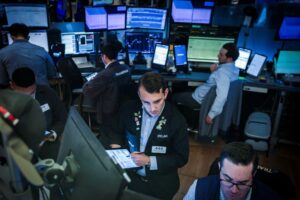President Trump Just Gave Stock Investors 2 Reasons to Worry About Another Market Crash
-
Severe tariffs recently reinstated by President Trump have pushed the average tax on U.S. imports to its highest level in decades.
-
Trump fired the Bureau of Labor Statistics (BLS) commissioner after insinuating the latest nonfarm payrolls numbers were fake.
-
The combination of severe tariffs, questions about economic data integrity, and already high valuations could lead to another stock market crash.
The U.S. stock market has taken investors for a bumpy ride this year. The benchmark S&P 500 (SNPINDEX: ^GSPC) fell as much as 19% from its record high when President Donald Trump announced sweeping “Liberation Day” tariffs on April 2, but the index swiftly rebounded when he paused the duties for 90 days.
However, Trump just gave investors two reasons to worry about another market crash: He recently reinstated modified versions of the severe tariffs announced earlier this year, and he fired the Bureau of Labor Statistics commissioner in a way that threatens to politicize the independent agency responsible for gathering economic data.
Here’s what investors should know.

Trump recently reinstated the reciprocal tariffs first announced on April 2. After a monthslong pause, during which the U.S. struck trade deals with a few countries, the new duties took effect on Aug. 7. Listed below are the tariff rates on top U.S. trading partners.
-
European Union: 15%
-
Mexico: 25%
-
China: 30%
-
Canada: 35%
-
Japan: 15%
Importantly, Canadian and Mexican imports in compliance with the free-trade agreement are not subject to tariffs listed above. Also, the 30% tariff on Chinese imports excludes pre-existing duties, and the rate is subject to change depending on the outcome of ongoing trade talks, which should conclude in the coming days.
The Budget Lab at Yale estimates tariffs have increased the average tax on U.S. imports to 18.6%, the highest level since 1933. Economists at Goldman Sachs and JPMorgan Chase put the figure closer to 17%, but the big picture is the same: The U.S. government is taxing imports at a rate not seen in nearly a century.
The consequences are difficult to predict due to the lack of historical data, but economists generally expect a one-time increase in inflation and a persistent drag on gross domestic product (GDP). For instance, the Budget Lab at Yale estimates tariffs will lower GDP growth by 0.5 percentage points in the next two years, and the Tax Foundation estimates tariffs will reduce GDP by 0.8% over the next decade.
That could sink the stock market because economic turbulence would lead to weaker corporate earnings. Consequently, Wall Street analysts have cut their earnings estimates for the S&P 500. The January consensus called for 14% growth in 2025, but the current consensus calls for 9.6% growth. And that number may be revised even lower after the dismal nonfarm payrolls report released earlier this month.
Recent data from the Bureau of Labor Statistics (BLS) suggests tariffs are starting to hurt the labor market. Nonfarm payrolls, which measure the number of employees across the U.S. economy excluding farm workers, increased 73,000 in July. That was a huge miss versus the consensus estimate that called for 110,000.
Even more alarming were the downward revisions to nonfarm payrolls data from previous months, as detailed below:
-
Nonfarm payrolls were originally reported to have increased 144,000 in May, but that figure was revised down to 19,000.
-
Nonfarm payrolls were originally reported to have increased 147,000 in June, but that figure was revised down to 14,000.
Revisions are commonplace because surveys used to estimate the number of workers in the economy continue to roll in for weeks after the initial report. But Trump, without offering evidence, asserted the latest downward revisions were a politically motivated attack. He reacted by firing BLS Commissioner Erika McEntarfer.
In some ways, that decision is even more worrisome than the dismal nonfarm payrolls numbers themselves. JPMorgan analyst Michael Feroli commented, “The risk of politicizing the data collection process should not be overlooked.” And Barclays analyst Ajay Rajadhyaksha wrote, “This move could lead to markets questioning data integrity, especially for releases that surprise investors.”
In short, investors now have cause to wonder whether the next BLS commissioner will manipulate data to make Trump happy. After all, McEntarfer seemingly lost her job simply because the agency released data that frustrated the president, as it suggested the labor market was weakening in response to his tariffs and the uncertainty they have created.
To summarize, Trump has imposed the most severe tariffs the U.S. economy has seen in decades. In turn, Wall Street analysts have substantially reduced their S&P 500 earnings estimates, and further downward revisions are possible (if not likely) following the latest nonfarm payrolls report.
Meanwhile, Trump created more uncertainty by firing the BLS commissioner while asserting without evidence the latest nonfarm payrolls numbers were phony. That begs the question: Will investors wonder if future BLS data has been manipulated? If so, the consequences for the stock market could be disastrous.
Those events are particularly worrisome because the S&P 500 already trades at a very rich valuation of 22.2 times forward earnings. Historically, the S&P 500 has dropped 6.4% in the year following incidents where its forward price-to-earnings multiple topped 22, according to hedge fund manager Leon Cooperman.
In short, the stock market would be on shaky ground without tariffs or questions about data integrity, but those variables make the current situation especially precarious. So, investors should mentally prepare for a decline. That means avoiding stocks that trade at absurd valuations and building a modest cash position.
Before you buy stock in S&P 500 Index, consider this:
The Motley Fool Stock Advisor analyst team just identified what they believe are the 10 best stocks for investors to buy now… and S&P 500 Index wasn’t one of them. The 10 stocks that made the cut could produce monster returns in the coming years.
Consider when Netflix made this list on December 17, 2004… if you invested $1,000 at the time of our recommendation, you’d have $636,563!* Or when Nvidia made this list on April 15, 2005… if you invested $1,000 at the time of our recommendation, you’d have $1,108,033!*
Now, it’s worth noting Stock Advisor’s total average return is 1,047% — a market-crushing outperformance compared to 181% for the S&P 500. Don’t miss out on the latest top 10 list, available when you join Stock Advisor.
*Stock Advisor returns as of August 4, 2025
JPMorgan Chase is an advertising partner of Motley Fool Money. Trevor Jennewine has no position in any of the stocks mentioned. The Motley Fool has positions in and recommends Goldman Sachs Group and JPMorgan Chase. The Motley Fool recommends Barclays Plc. The Motley Fool has a disclosure policy.
President Trump Just Gave Stock Investors 2 Reasons to Worry About Another Market Crash was originally published by The Motley Fool







